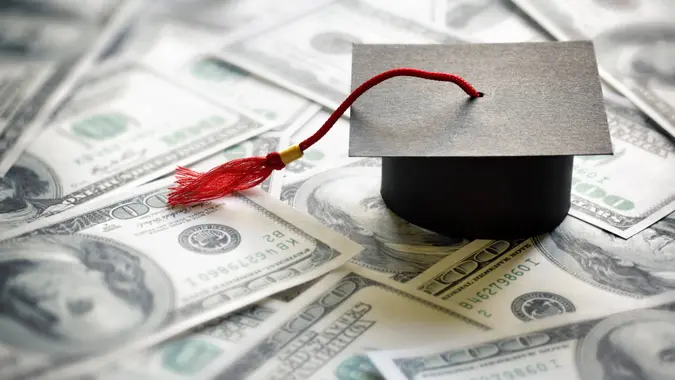Car Owners Want To Walk Away From Their Car Loans — How Can You Do That?

Commitment to Our Readers
GOBankingRates' editorial team is committed to bringing you unbiased reviews and information. We use data-driven methodologies to evaluate financial products and services - our reviews and ratings are not influenced by advertisers. You can read more about our editorial guidelines and our products and services review methodology.

20 Years
Helping You Live Richer

Reviewed
by Experts

Trusted by
Millions of Readers
Although new car prices have flattened year-over-year, they’re still elevated. The average transaction price for new cars climbed 2.2% from March to April and now sits at $48,510, per Kelley Blue Book (KBB). With high prices comes high interest rates, monthly payments and average loan balances.
According to Experian, American consumers’ averaged $23,792 in auto loan balances, an increase of 5.2% from 2022. Thanks to increased sticker prices, higher rates and longer terms (the average auto loan term is 68 months for a new vehicle), car owners owed $1.51 trillion on vehicles, according to 2023 third quarter stats.
With so much tied up in auto debt and everything else expensive even as inflation cools, more U.S. households than ever are finding it hard to keep up with monthly car payments and more are trying to do anything to get out of their car loans.
If you’re of the opinion that getting out of a signed contract is hopeless, read the following five ways you can unburden yourself from taxing monthly loan payments. They’re not painless but they might provide a way to ease or even walk away from your current difficult financial situation.
1. Pay Your Loan Off
If you have the money and want to get out of the loan as soon as possible, paying off your vehicle loan in one lump sum is probably your best option. Of course, that’s easier said than done. The main reason many people take out car loans is because they don’t have the money to buy a vehicle straight up. Paying off the loan will help immensely, but you can’t do it at the expense of essential living expenses.
Paying off your loan will save you a ton of interest over the long run, however, with some car loan agreements, there’s there might be penalties associated with an early payoff. This payoff amount will depend on what you and your lender agreed to when discussing the terms of your contract. Therefore, you will have to pay the remaining loan principal plus the contracted payoff penalty — typically 2% of the remaining loan balance — if there is one.
2. Sell Your Vehicle
For some, a car is an absolute necessity. For others, it’s an expensive convenience. Many people choose to sell their car privately for cash that can be used to pay off their car loan. If you can afford to get rid of your car and this option intrigues you, the first thing you should do is plug in your car’s year, make, model and mileage to an online value calculator to determine its value.
Most car experts — KBB, Edmunds, Car and Driver, Consumer Reports, Carfax, etc. — have these free to use on their sites. Additionally, check with your lender if you can easily transfer the loan to the buyer, if that is their preferred transaction approach.
3. Refinance of Renegotiate Your Loan
There’s nothing stopping someone from looking into renegotiating or refinancing their existing car loan. If you’re currently having trouble coming up with your monthly payments, you might not qualify for a lower rate, but it’s worth a shot and might be your most viable way to keep your car, pay off your debt quicker and save money.
Improving your credit score or getting a new, higher-paying job may put you in a position to refinance your debt at a lower annual percentage rate (APR) or longer term. However, make sure to crunch some numbers first. Getting a lower rate at a longer term isn’t worth your while if you’re paying more interest over the loan term.
4. Trade in Your Car
Switching to a less expensive vehicle that meets your budget happens all the time at car dealerships. When you trade-in a vehicle with a loan, the dealer will ideally offer you enough for your trade-in that will allow you to pay off the loan balance. Then, you can start fresh with a new car, new loan, and hopefully a lower monthly payment.
But, as Lending Tree points out, being “upside down” on your car loan (owing more on the car than it’s worth), will probably mean an offer on your car from a dealer won’t be a lot and possibly not enough to pay off the entire loan.
5. Surrender Your Vehicle
Car loans are secured debts, so the lender can repossess your vehicle if you stop making payments.
A surrender is when you as the owner voluntarily gives the vehicle back to the lender when you file for insolvency proceedings. According to Car and Driver, once the creditor takes possession of your car and eventually sells it, you’ll receive a statement outlining the “deficiency balance,” which is the amount you still owe the lender.
“Realize, however, that you will still be liable for any added costs or losses the company takes because of the surrender,” says Cartalk.com. “Usually in the form of differences between what the vehicle can sell for versus what you owed and any towing or dealership fees associated. This will also have a negative impact on your credit record, so think carefully about going this route.”
 Written by
Written by  Edited by
Edited by 
























